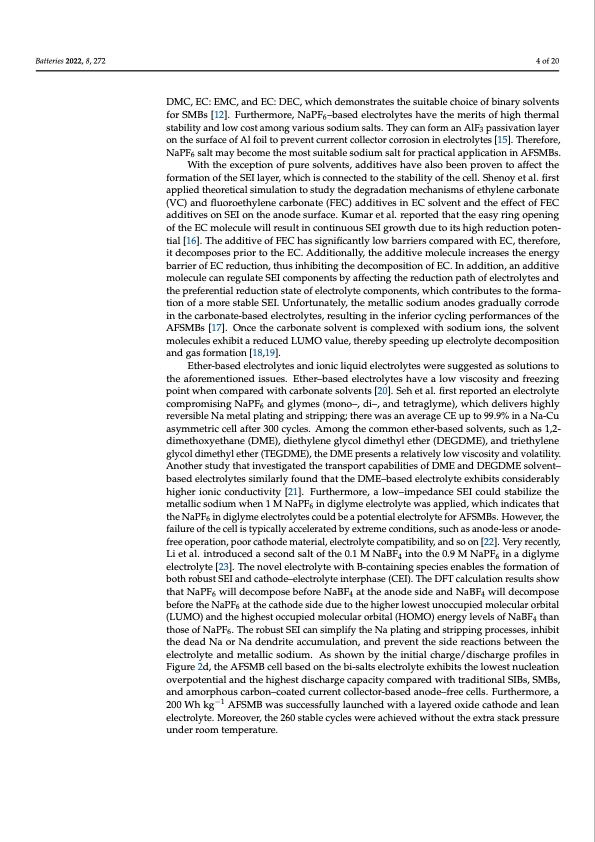
PDF Publication Title:
Text from PDF Page: 004
Batteries 2022, 8, 272 4 of 20 DMC, EC: EMC, and EC: DEC, which demonstrates the suitable choice of binary solvents for SMBs [12]. Furthermore, NaPF6–based electrolytes have the merits of high thermal stability and low cost among various sodium salts. They can form an AlF3 passivation layer on the surface of Al foil to prevent current collector corrosion in electrolytes [15]. Therefore, NaPF6 salt may become the most suitable sodium salt for practical application in AFSMBs. With the exception of pure solvents, additives have also been proven to affect the formation of the SEI layer, which is connected to the stability of the cell. Shenoy et al. first applied theoretical simulation to study the degradation mechanisms of ethylene carbonate (VC) and fluoroethylene carbonate (FEC) additives in EC solvent and the effect of FEC additives on SEI on the anode surface. Kumar et al. reported that the easy ring opening of the EC molecule will result in continuous SEI growth due to its high reduction poten- tial [16]. The additive of FEC has significantly low barriers compared with EC, therefore, it decomposes prior to the EC. Additionally, the additive molecule increases the energy barrier of EC reduction, thus inhibiting the decomposition of EC. In addition, an additive molecule can regulate SEI components by affecting the reduction path of electrolytes and the preferential reduction state of electrolyte components, which contributes to the forma- tion of a more stable SEI. Unfortunately, the metallic sodium anodes gradually corrode in the carbonate-based electrolytes, resulting in the inferior cycling performances of the AFSMBs [17]. Once the carbonate solvent is complexed with sodium ions, the solvent molecules exhibit a reduced LUMO value, thereby speeding up electrolyte decomposition and gas formation [18,19]. Ether-based electrolytes and ionic liquid electrolytes were suggested as solutions to the aforementioned issues. Ether–based electrolytes have a low viscosity and freezing point when compared with carbonate solvents [20]. Seh et al. first reported an electrolyte compromising NaPF6 and glymes (mono–, di–, and tetraglyme), which delivers highly reversible Na metal plating and stripping; there was an average CE up to 99.9% in a Na-Cu asymmetric cell after 300 cycles. Among the common ether-based solvents, such as 1,2- dimethoxyethane (DME), diethylene glycol dimethyl ether (DEGDME), and triethylene glycol dimethyl ether (TEGDME), the DME presents a relatively low viscosity and volatility. Another study that investigated the transport capabilities of DME and DEGDME solvent– based electrolytes similarly found that the DME–based electrolyte exhibits considerably higher ionic conductivity [21]. Furthermore, a low–impedance SEI could stabilize the metallic sodium when 1 M NaPF6 in diglyme electrolyte was applied, which indicates that the NaPF6 in diglyme electrolytes could be a potential electrolyte for AFSMBs. However, the failure of the cell is typically accelerated by extreme conditions, such as anode-less or anode- free operation, poor cathode material, electrolyte compatibility, and so on [22]. Very recently, Li et al. introduced a second salt of the 0.1 M NaBF4 into the 0.9 M NaPF6 in a diglyme electrolyte [23]. The novel electrolyte with B-containing species enables the formation of both robust SEI and cathode–electrolyte interphase (CEI). The DFT calculation results show that NaPF6 will decompose before NaBF4 at the anode side and NaBF4 will decompose before the NaPF6 at the cathode side due to the higher lowest unoccupied molecular orbital (LUMO) and the highest occupied molecular orbital (HOMO) energy levels of NaBF4 than those of NaPF6. The robust SEI can simplify the Na plating and stripping processes, inhibit the dead Na or Na dendrite accumulation, and prevent the side reactions between the electrolyte and metallic sodium. As shown by the initial charge/discharge profiles in Figure 2d, the AFSMB cell based on the bi-salts electrolyte exhibits the lowest nucleation overpotential and the highest discharge capacity compared with traditional SIBs, SMBs, and amorphous carbon–coated current collector-based anode–free cells. Furthermore, a 200 Wh kg−1 AFSMB was successfully launched with a layered oxide cathode and lean electrolyte. Moreover, the 260 stable cycles were achieved without the extra stack pressure under room temperature.PDF Image | Anode-Free Rechargeable Sodium-Metal Batteries

PDF Search Title:
Anode-Free Rechargeable Sodium-Metal BatteriesOriginal File Name Searched:
batteries-08-00272.pdfDIY PDF Search: Google It | Yahoo | Bing
Salgenx Redox Flow Battery Technology: Salt water flow battery technology with low cost and great energy density that can be used for power storage and thermal storage. Let us de-risk your production using our license. Our aqueous flow battery is less cost than Tesla Megapack and available faster. Redox flow battery. No membrane needed like with Vanadium, or Bromine. Salgenx flow battery
| CONTACT TEL: 608-238-6001 Email: greg@salgenx.com | RSS | AMP |